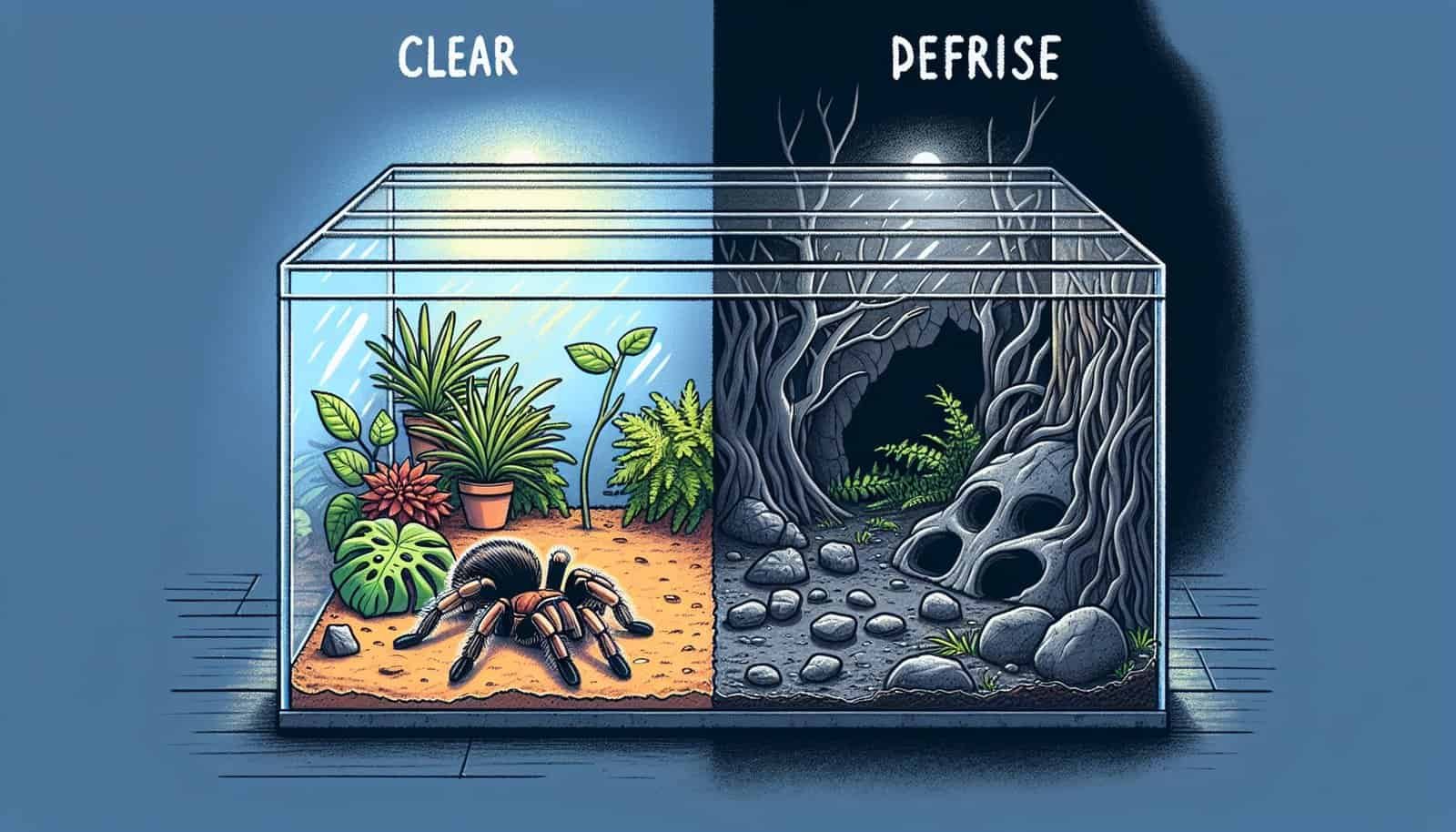Imagine the thrill of owning a tarantula as a pet, with its eight legs and mysterious aura. But as you set up its new home, a question arises: should you keep your arachnid companion in a clear enclosure or a dark one? While the answer may not be as straightforward as you’d expect, this article will shed light on the preferences of tarantulas when it comes to their living quarters. So, sit back, relax, and join us on this fascinating journey into the world of tarantula habitats.

Clear Enclosures vs Dark Ones: Which is Better for Tarantulas?
Importance of Choosing the Right Enclosure for Tarantulas
When it comes to keeping tarantulas as pets, providing them with the right enclosure is of utmost importance. The enclosure you choose can significantly impact the tarantula’s health, behavior, and overall well-being. There are two main types of enclosures commonly used for tarantulas: clear enclosures and dark enclosures. In this article, we will explore the benefits and drawbacks of each, as well as factors to consider when making your decision.
Benefits and Drawbacks of Clear Enclosures
Clear enclosures, typically made of glass or acrylic, offer several advantages for tarantulas. One of the most significant benefits is enhanced visibility. As an owner, being able to observe your tarantula in its natural habitat can be fascinating and rewarding. Clear enclosures also allow for easy observation and monitoring of the tarantula’s behavior, feeding habits, and overall health.
Another advantage of clear enclosures is that they promote natural day-night cycles. Having access to natural light can help regulate the tarantula’s internal clock, ensuring it follows its normal behavioral patterns. This is especially important for tarantulas that are diurnal or crepuscular.
Clear enclosures also help prevent mold and fungal growth. With clear enclosures, you can easily identify any signs of mold or excessive moisture, allowing you to take prompt action and ensure a healthier living environment for your tarantula.
However, there are some drawbacks to consider when using clear enclosures. The increased light exposure in clear enclosures may result in potential stress and agitation for some tarantulas. Tarantulas are generally nocturnal creatures and prefer darker environments. The excess light from clear enclosures can disrupt their natural behavior and potentially affect their overall well-being.
Another drawback of clear enclosures is the limited privacy they provide. Tarantulas, like many other animals, thrive when they have a place to hide and feel secure. Clear enclosures make it challenging for tarantulas to find adequate hiding spots, which can lead to increased stress and anxiety.
Additionally, regulating temperature and humidity levels can be more challenging in clear enclosures. The transparency of the enclosure allows heat and moisture to escape more easily, making it harder to create and maintain the ideal environment for your tarantula.
Benefits and Drawbacks of Dark Enclosures
Dark enclosures, often made of plastic or opaque materials, offer a different set of advantages for tarantulas. One significant benefit is that they replicate the tarantula’s natural environment more closely. In the wild, tarantulas reside in burrows or caves, where they have limited exposure to light. Dark enclosures provide them with the security and privacy they need to feel comfortable and thrive.
Dark enclosures also limit exposure to light and UV radiation, which can be detrimental to tarantulas. Unlike humans, tarantulas do not have the protective mechanisms to shield themselves from these harmful rays. Dark enclosures serve as a shield, reducing the risk of eye damage or other light-related complications.
Regulating temperature and humidity levels is generally easier in dark enclosures. The opaque nature of these enclosures helps retain heat and moisture, creating a more stable environment for the tarantula. This stability is crucial for their overall health and well-being.
However, there are some drawbacks to consider when choosing dark enclosures. The reduced visibility and observation of tarantulas in dark enclosures may not be ideal for all pet owners. Some individuals enjoy being able to see their tarantulas’ activities and behaviors more clearly, which is not possible in dark enclosures.
Similar to clear enclosures, dark enclosures may also pose a risk of mold and fungal growth if not properly maintained. The lack of light can create a more humid environment, increasing the chances of these issues. It is essential to strike a balance between providing a dark enclosure and ensuring proper ventilation to avoid these potential problems.
Factors to Consider when Choosing Enclosures for Tarantulas
When deciding between clear and dark enclosures for your tarantula, it is crucial to consider several factors to meet their specific needs.
Natural Habitat and Behavior of Tarantulas
Understanding the natural habitat and behavior of your tarantula species is essential. Some tarantulas naturally reside in darker environments, while others prefer more light. Research the specific requirements of your tarantula species to help guide your decision.
Light and UV Sensitivity
Consider the sensitivity of tarantulas to light and UV radiation. While some species can tolerate more light exposure, others are more sensitive and may fare better in darker enclosures. A balance must be struck to prevent any potential harm or stress to the tarantula.
Temperature and Humidity
Tarantulas have specific temperature and humidity requirements that must be met to maintain optimal health. Clear enclosures may require more effort to regulate these factors, while dark enclosures often provide a more stable environment. Choose an enclosure that aligns with the tarantula’s temperature and humidity needs.
Exposure to External Stimuli
Tarantulas, like many other animals, can be sensitive to external stimuli such as loud noises or vibrations. Consider the overall environment in which the enclosure will be placed. If your living space is often filled with commotion, a dark enclosure may provide a more peaceful environment for your tarantula.
Aesthetics and Visibility
Personal preferences must also be taken into account. While the well-being of your tarantula should be the primary concern, it is important to choose an enclosure that aligns with your aesthetic preferences and allows for adequate visibility if that is important to you.
Advantages of Clear Enclosures for Tarantulas
Enhanced Visibility
One of the most notable advantages of clear enclosures is enhanced visibility. Being able to observe your tarantula in its natural habitat can be a truly captivating experience. You can witness its unique behaviors, hunting techniques, and molting process up close. This visibility allows you to form a deeper connection with your pet and gain a better understanding of its needs and preferences.
Promotes Natural Day-Night Cycles
Clear enclosures provide natural light exposure, which can help regulate the tarantula’s internal clock and promote a healthy day-night cycle. Access to natural light allows the tarantula to follow its natural behavioral patterns, facilitating a more balanced and fulfilled life.
Easy Observation and Monitoring
With clear enclosures, observing and monitoring the tarantula becomes effortless. You can easily check on its overall health, feeding habits, and behavior without disturbing its natural environment. This accessibility allows for better care and timely intervention if any health issues arise.
Prevents Mold and Fungal Growth
Clear enclosures make it easier to identify any signs of mold or excessive moisture, preventing potential health hazards for your tarantula. Mold and fungal growth can be detrimental to their well-being and may lead to respiratory problems or infections. With clear enclosures, prompt action can be taken to address any moisture issues and ensure a healthier living environment.
Disadvantages of Clear Enclosures for Tarantulas
Increased Light Exposure
Clear enclosures expose tarantulas to a higher level of light than they would typically experience in their natural habitat. This increased light exposure can lead to stress, agitation, and potentially disrupt their natural behavior and sleep patterns. Tarantulas are primarily nocturnal creatures and prefer darker environments for their overall well-being.
Limited Privacy
Tarantulas, like many other animals, thrive when they have a place to hide and feel secure. Clear enclosures make it challenging for tarantulas to find adequate hiding spots, which can lead to increased stress and anxiety. Lack of privacy can negatively impact their well-being and behavior, causing them to become more reclusive or exhibit signs of distress.
Potential Stress and Agitation
Some tarantulas are highly sensitive creatures and may become stressed or agitated due to the increased visibility and external stimuli provided by clear enclosures. The constant presence of humans or disturbances can be overwhelming for them, impacting their overall health and behavior.
Difficulty Regulating Temperature and Humidity
Creating and maintaining the ideal temperature and humidity levels within clear enclosures can be more challenging. The transparent nature of these enclosures allows heat and moisture to escape more easily, requiring more effort to ensure the tarantula’s comfort and well-being. Constant monitoring and adjustments may be necessary, which can be time-consuming for some keepers.
Advantages of Dark Enclosures for Tarantulas
Replicates Natural Environment
Dark enclosures closely resemble the natural environment in which tarantulas reside, such as burrows or caves. Providing an enclosure that mirrors their natural habitat helps create a sense of security and comfort for the tarantula. This can result in a more content and relaxed tarantula, ultimately leading to better overall health.
Provides Security and Privacy
Dark enclosures offer greater privacy and hiding spots for tarantulas. Having a secure and secluded space allows them to retreat and feel safe when they desire solitude. This privacy leads to lower stress levels and promotes natural behavior patterns, ensuring a healthier and more thriving tarantula.
Limits Exposure to Light and UV
Tarantulas lack protective mechanisms against harmful rays, making excessive light exposure a concern. Dark enclosures serve as a shield, reducing the risk of eye damage and other light-related complications. By limiting light and UV exposure, dark enclosures provide a safer and more suitable environment for tarantulas.
Easier Temperature and Humidity Regulation
Dark enclosures often require less effort to regulate temperature and humidity levels. The opaque nature of these enclosures helps retain heat and moisture, creating a more stable environment for the tarantula. This stability is crucial for their overall health, as fluctuations in temperature and humidity can lead to stress and health issues.

Disadvantages of Dark Enclosures for Tarantulas
Reduced Visibility and Observation
One notable drawback of dark enclosures is the reduced visibility of tarantulas. If observing your tarantula’s activities and behaviors is important to you as an owner, a dark enclosure may not be the ideal choice. The limited visibility can make it challenging to monitor your pet closely and gain insight into its well-being.
Potential Mold and Fungal Growth
The lack of light in dark enclosures can create an environment prone to mold and fungal growth if not properly managed. The higher humidity levels within dark enclosures may contribute to these issues. Regular maintenance and monitoring are necessary to ensure a healthy living space for your tarantula.
Difficulty Maintaining Day-Night Cycles
Dark enclosures may make it challenging to establish and maintain natural day-night cycles for your tarantula. Without access to natural light, the tarantula’s internal clock may become disrupted, potentially affecting its overall behavior and well-being. Additional measures such as introducing artificial lighting may be necessary to create a balanced routine.
Tips for Creating Optimal Enclosure Conditions
To ensure the well-being of your tarantula, regardless of whether you choose a clear or dark enclosure, here are some general tips to create optimal enclosure conditions:
Choosing Suitable Substrates
Select appropriate substrates for the enclosure that mimic the tarantula’s natural habitat. The substrate should retain moisture well without becoming overly wet. Common substrates include coconut fiber, peat moss, or a mixture of both.
Providing Adequate Hiding Spots
Regardless of the enclosure type, it is crucial to provide your tarantula with hiding spots. This can be in the form of artificial burrows, commercial hides, or even cork bark. Hiding spots allow your tarantula to feel secure and reduce stress levels.
Using Appropriate Lighting and Heat Sources
If you opt for a clear enclosure, choose lighting sources that replicate natural daylight. Full spectrum or LED lights can help simulate the natural light spectrum, promoting the tarantula’s well-being. Additionally, ensure that any heat sources used, such as heat pads or ceramic heaters, are suitable for tarantulas and do not pose a safety risk.
Maintaining Ideal Temperature and Humidity Levels
Regularly monitor and adjust the temperature and humidity levels within the enclosure to ensure they align with your tarantula’s specific requirements. Investing in a reliable thermometer and hygrometer is recommended to maintain optimal conditions for your pet.
Avoiding Excessive Disturbance
While it can be tempting to constantly observe and interact with your tarantula, it is important to minimize excessive disturbance. Tarantulas are generally solitary creatures and prefer minimal interference. Avoid frequent handling or loud noises that may stress the tarantula. Respect their space and provide a peaceful environment to support their overall well-being.

Case Studies: Tarantula Owners’ Experiences
Clear Enclosure Success Stories
Many tarantula owners have had great success using clear enclosures for their pets. The enhanced visibility allows them to closely observe and interact with their tarantulas, gaining insights into their behavior and habits. The ability to monitor their tarantula’s health closely has enabled prompt intervention and treatment when necessary, leading to overall healthier and happier tarantulas.
Dark Enclosure Success Stories
Tarantula owners who have opted for dark enclosures have also reported positive experiences. The greater privacy and security provided by these enclosures have resulted in calmer and more relaxed tarantulas. Observing natural behaviors, such as burrowing or web-building, has been possible despite the reduced visibility. Tarantulas in dark enclosures have thrived and shown signs of contentment.
Challenges and Lessons Learned
It is important to acknowledge that each tarantula is unique, and their preferences may vary. Some owners have shared challenges they faced when choosing clear or dark enclosures. Encountering unexpected stress or aggression in tarantulas placed in clear enclosures has prompted adjustments to ensure a more suitable environment. Similarly, some owners using dark enclosures have had to find a balance between privacy and visibility to cater to their tarantula’s specific needs.
Experimentation and Personal Preferences
Tarantulas, like any living creatures, can exhibit varied responses to different enclosure types. While certain species may be more inclined towards clear enclosures due to their natural habitat, individual preferences can also play a significant role. Factors such as temperament, age, and previous living conditions may influence how well a tarantula adapts to a particular enclosure.
It is essential for keepers to balance both the tarantula’s well-being and their personal satisfaction. While it is important to create a suitable living environment based on their needs, it is equally vital for the owner to feel satisfied and engaged in the tarantula-keeping experience.

Conclusion
When choosing an enclosure for your tarantula, there is no one-size-fits-all solution. It is essential to consider the tarantula species’ natural habitat, light and UV sensitivity, temperature and humidity requirements, exposure to external stimuli, and personal preferences.
Clear enclosures offer enhanced visibility, promote natural day-night cycles, and allow for easy observation and monitoring. However, they may result in increased light exposure, limited privacy, potential stress, and difficulty in regulating temperature and humidity.
Dark enclosures replicate the tarantula’s natural environment, provide security and privacy, limit light and UV exposure, and ease temperature and humidity regulation. However, they can reduce visibility, potentially contribute to mold and fungal growth, and make it challenging to maintain day-night cycles.
By understanding the tarantula’s requirements and considering personal preferences, you can find the right balance for your tarantula. Providing suitable enclosure conditions will contribute to their overall well-being, allowing them to live a happy and healthy life in captivity.
